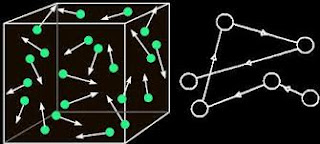In physics, motion is a change in position of an object with respect to time and
its reference point. Motion is typically described in terms of displacement, velocity, acceleration, and time. Motion is observed by
attaching a frame of reference to a body and measuring its change in
position relative to another reference frame.
A body which does not move is said to be at
rest, motionless, immobile, stationary,
or to have constant (time-invariant) position. An object's motion cannot change
unless it is acted upon by a force, as described by Newton's first law. An object's momentum is directly related to the object's mass and velocity, and the total momentum of
all objects in a closed system (one not affected by external forces)
does not change with time, as described by the law of conservation of momentum.
As there is no absolute frame of reference, absolute
motion cannot be
determined. Thus,
everything in the universe can be considered to be moving.
More generally, the term
motion signifies a continuous change in the configuration of a physical system.
For example, one can talk about motion of a wave or a quantum particle (or any
other field) where the configuration consists of probabilities of occupying
specific positions.
Types of Motion
·
Simple harmonic motion - is a type of periodic
motion where the restoring force is directly proportional to the
displacement. It can serve as a mathematical model of a variety of motions, such as the oscillation of a spring. In
addition, other phenomena can be approximated by simple harmonic motion,
including the motion of a simple
pendulum as well as molecular vibration.
Example:
a pendulum
Periodic
motion - in physics, motion repeated in equal intervals of time.
Example: rocking chair, a bouncing ball, a vibrating
tuning fork
Rectilinear
motion (Linear motion) –
motion which follows a straight linear path, and whose displacement is exactly the same as its trajectory.
Example: apple falling from a
tree
Reciprocating Motion - repetitive up-and-down or back-and-forth motion. It is found in a wide range of mechanisms, including reciprocating engines and pumps. The
two opposite motions that comprise a single reciprocation cycle are called strokes
Example: gears
in a machine
·
Brownian
motion - is the presumably random moving of particles suspended
in a fluid (a liquid or a gas)
resulting from their bombardment by the fast-moving atoms or molecules in
the gas or liquid.
Examples: the random movement of
particles
Circular motion - is a movement of an
object along the circumference of a circle or rotation along
a circular path. It can be uniform, with constant angular rate of rotation (and
constant speed), or non-uniform with a changing rate of rotation. The rotation around a fixed axis of a
three-dimensional body involves circular motion of its parts. The equations of
motion describe the movement of the center
of mass of a body.
Examples: the orbits of planets
·
Rotary
motion – a
motion about a fixed point.
Examples: Ferris wheel
Curvilinear
motion – It
is defined as the motion along a curved path that may be planar or in three
dimensions.
Example:
a ball that is thrown
Rolling motion - is a type of motion that combines rotation (commonly, of an axially symmetric object) and translation of that object with respect
to a surface (either one or the other moves), such that, if ideal conditions
exist, the two are in contact with each other without sliding.
Example: the wheel of a bicycle
Oscillation
- is the repetitive variation, typically in time, of
some measure about a central value (often a point of equilibrium) or
between two or more different states. Familiar examples include a swinging pendulum and AC power. The term vibration is
sometimes used more narrowly to mean a mechanical oscillation but is sometimes
used as a synonym of "oscillation". Oscillations occur not only in
physical systems but also in biological
systems, from human society to
the brain.
Example:
a spring system is an oscillatory system










Walang komento:
Mag-post ng isang Komento